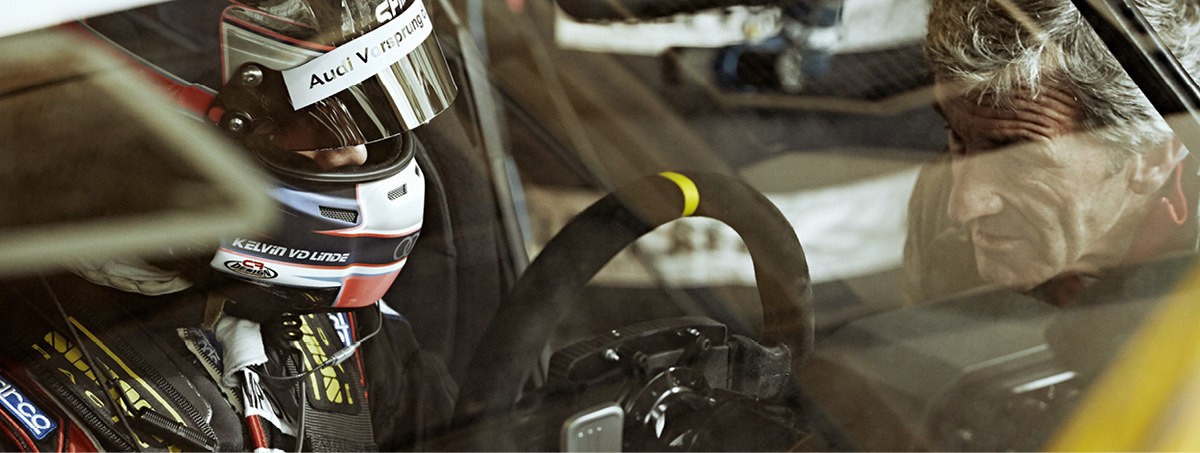
The academy of fast arts
Math class on aerodynamics, physics class on driving—the Audi Sport racing academy offers an education of a very special kind. Here, the next generation of racing car drivers are groomed for careers in professional motorsport.
Hermann Müller (copy) & Benne Ochs (photo)A glance at the academy’s lecture hall instantly makes it clear that this is no ordinary school. Little bigger than a hotel room, it’s furnished with a desk, corner couch, two armchairs and a big screen. Comfort isn’t a big priority in the Audi Sport racing academy’s team truck and mobile classroom. There’s space for six students at most—the maximum number accepted into the program. Launched this year, the academy complements the four rings’ existing motorsport commitments by adding an attractive entry-level program for shaping young talent into professional racing drivers. “With the Audi Sport racing academy, we’re closing a gap in our increasingly comprehensive offering and raising the sporting profile of our global activities,” says Klaus Demel, head of Audi driving experience. The process of selecting the most promising young guns involves assessments and tests overseen by a jury including Sepp Haider, head of Audi race experience, Dirk Spohr, head of customer management at Audi Sport customer racing, plus seasoned sports car pilot Pierre Kaffer as well as other Audi Sport decision makers. Naturally, theory is by no means the program’s sole focus. In conjunction with instruction on basic aerodynamics and driving physics, personal fitness as well as how to deal with the media and sponsors, the up-and-coming racers are given plenty of opportunity to put in time behind the wheel. This spans the arc from driver training on icy surfaces in Finland to test drives at the Audi driving experience center in Neuburg an der Donau and on racetracks.
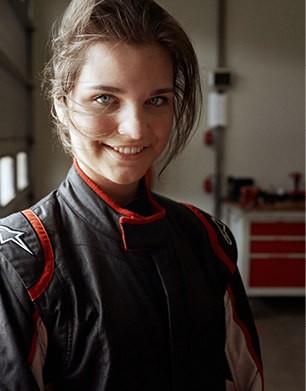
Vivien KeszthelyiKarting was never her thing. At the tender age of 12, Vivien saw her first motor race. By 13, she was already lining up at the start. At 14, she took third place in the overall rankings at the Salzburgring racetrack despite rolling the car eight times. Now 15 years old, Vivien Keszthelyi finds it “pretty weird” that she’s still not allowed to drive on public roads. But she takes comfort that her parents are behind her every step of the way and at least on track she can really put the pedal to the metal. This year, she’ll be contesting the Hungarian touring car championships in her Audi TT cup, going head to head with Lamborghinis. Thanks to the Audi Sport racing academy, she’s confident that by being “faster through the corners,” she’ll be able to get onto the podium.

At the tender age of just 15, Vivien Keszthelyi from Hungary is the youngest participant at the Audi Sport racing academy.

Sheldon Van der LindeFor the 16-year-old South African, there never was an alternative to the racetrack. His grandfather, father and uncle were racing drivers. Even as a baby, he was crawling around the paddocks in East London and Kyalami. Already he is well on his way to claiming his destiny, having entered his first kart race at the age of five and won the South African Junior Championships at nine. In the last two years, he has dominated the national VW Polo Cup. Standing 1.80 meters tall and weighing just 50 kilos, the young athlete has steeled his body in triathlons. In the medium term, he aims to use the Audi TT Cup as a springboard to get where his brother Kelvin already is—in the cockpit of an Audi R8 LMS. His long-term goal is the DTM and his deep faith is sure to see him through: “With God’s help, nothing is impossible,” says Sheldon.
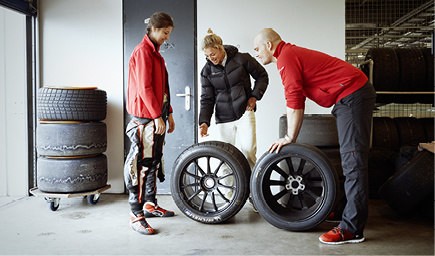
There, Rahel Frey (center) is already lecturing on the different properties of various tire compounds.
Or on the Nürburgring Grand Prix circuit, which is where 15-year-old Hungarian Vivien Keszthelyi, 17-year-old South African Sheldon van der Linde and 19-year-old Dane Nicklas Nielsen are currently being initiated into circuit racing. Under the watchful eyes of Sepp Haider, Pierre Kaffer and former DTM racer Rahel Frey, the candidates are getting acquainted with the “amateurs’” 449-kilowatt Audi R8 V10 plus and the ideal line. No easy feat for the trio who are used to racing competitively in cars with significantly less thrust. Vivien Keszthelyi comments laconically, “It was intense.” But she’s not the only one blown away by the experience.
Fellow traveler Sheldon van der Linde is two-time overall winner of the South African VW Polo Cup but he, too, is “deeply impressed.” For Nicklas Nielsen, the leap to the Audi R8 V10 plus is probably the biggest, as the Dane has only raced in karts before. With tremendous success. After the hour-long warm-up session, Sepp Haider is full of praise for the three: “Nicely done. Their attitude is great and they learn very quickly. Plus, they’re already instinctive drivers—if the car jerks slightly, they don’t panic but countersteer perfectly.” Surprisingly, it’s the youngest of the bunch who is most resistant to the electronic driving aids in the Audi R8. Vivien Keszthelyi’s cocky response is: “I prefer being able to control everything myself.”

Vivien Keszthelyi listens attentively to the discussion in the race truck and 03 talks to Pierre Kaffer (left) and Sepp Haider (center) during a short break in training.
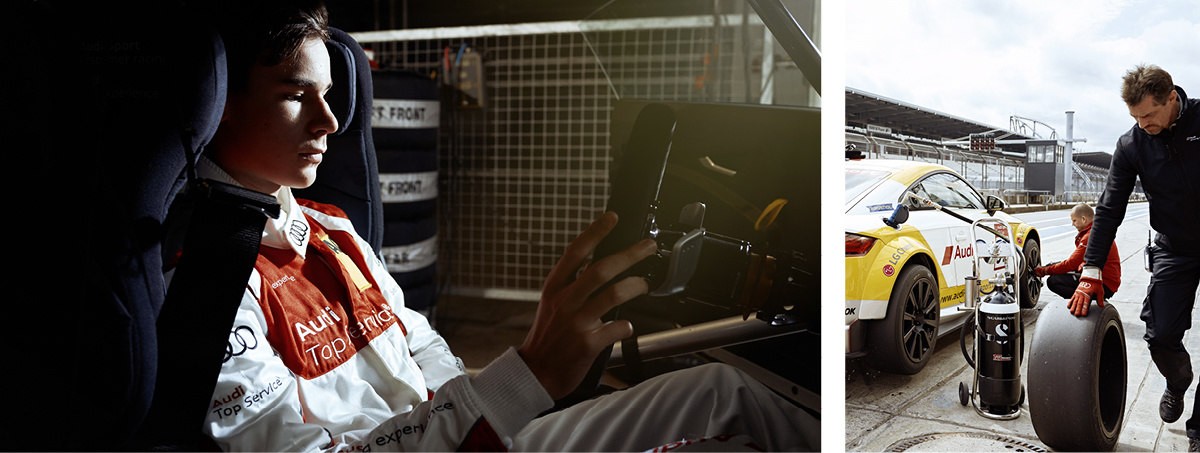
Sheldon van der Linde is fully focused in the cockpit of the Audi TT cup.

The Audi Sport racing academy curriculum includes much more than just driver training. According to mentor Sepp Haider, technical know-how, mental training as well as PR and sponsorship work are just as important.
The Audi Sport racing academy has places for a maximum of six drivers a year. Its goal is to challenge and promote the motorsport stars of the future.


Nicklas NielsenAt 19 years of age, the blonde Dane from Aarhus may be the eldest recruit to the Audi Sport racing academy but he already has 16 years’ driving experience under his belt. For his son’s third birthday, Nielsen senior ordered a kart with a lawnmower motor. For a long time, Nicklas stuck with the mini speedsters, winning the WSK Euro Series in 2013 and the WSK Champions Cup in 2015. This year, he made his debut in both Formula 4 and the Audi Sport TT Cup, which proved a tall order: “I constantly have to switch between front and rear-wheel drive. But it’s valuable experience.” The Fernando Alonso fan also likes to mix things up in his fitness training: “I push hard mountain biking and relax playing golf.”
The Hungarian gets her wish in the very next training unit in the Audi TT cup—which is, after all, a thoroughbred racing machine. While its 228 kilowatts provide less grunt than the Audi R8 V10 plus, it weighs a mere 1,125 kilograms, rides on smooth-tread slicks and features a cockpit design that ordinary road users would find baffling. Yet again, the trio of youngsters master coordinator Sepp Haider’s instruction to “drive smoothly, cleanly and fast.” Lap after lap, they keep on getting faster. Ultimately, they are even able to accurately analyze the effects of a change in suspension setup on driving dynamics made during a brief pit stop. “All three were really very fast and can already correctly gauge how the car will behave when pushed to its limits,” summarizes Sepp Haider, before moving on to individual assessments. “Nicklas was a true professional. His karting background means he was only familiar with rear-wheel drive. As a result, he was a little hesitant at first but by the end was just as fast as Sheldon who, after two years competing in the Polo Cup, is very comfortable with front-wheel drive on racetracks. Vivian was the biggest surprise. She’s only 15 but unbelievably smart and totally cool—she didn’t miss the braking point or spin once.”
Performance stats are captured in the form of video recordings and data downloaded from the on-board computer onto data engineer Gernot Ludwigs’ laptop during each pit stop. These facts and figures are the starting point for discussion during a wrap-up in the race truck. Hundreds of readings are taken, ranging from brake pressure, through steering angle, to exact GPS locations on the racetrack. All of this information is not only useful material for data analysis but also a valuable source of tips on how to improve lap times. At the same time, the data tracks the lines individual drivers take on the circuit. As Gernot Ludwigs explains, “That’s when you can see exactly how different an old hand’s line is from a rookie’s. Then you can say to the young talent: See that? That’s what we have to work on.”
Just how far these new insights will take the three young racers should already become apparent this motorsport season. Sheldon van der Linde and Nicklas Nielsen will already be entering the Audi Sport TT Cup this year, which forms part of the Audi Sport Brand Cup and DTM ancillary program. Due to her tender age, Vivien Keszthelyi will initially only be participating in national races in Hungary. Sepp Haider explains the long game: “In the medium term, our young pilots should be able to try out for selection as Audi Sport or Audi Sport customer racing drivers in the LMP, DTM or GT3. Ideally, they’ll one day be works drivers for Audi. With the Audi Sport racing academy, we are creating an ideal program to support them on their first steps toward a racing career.”
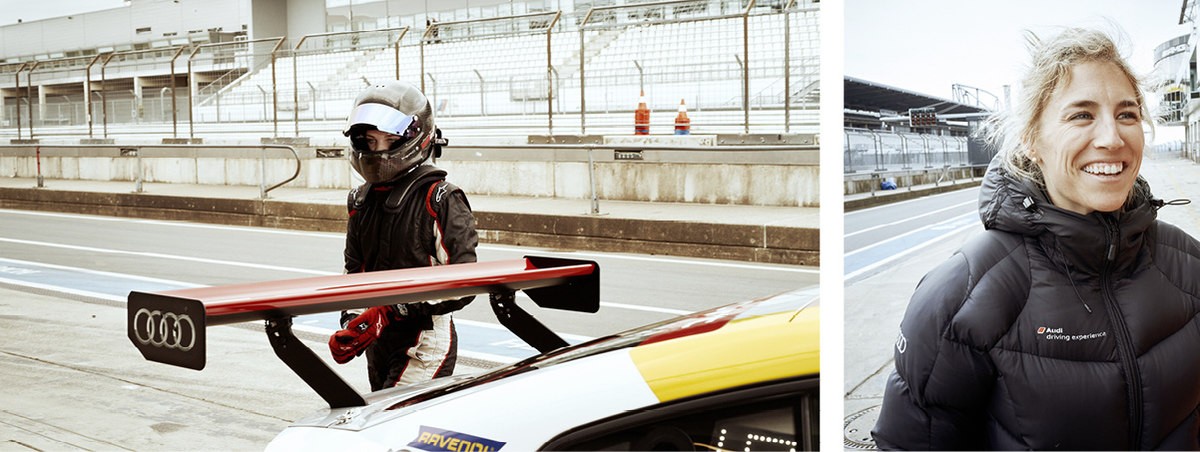
Audi Sport racing academy
This is where today’s young talent is being molded into tomorrow’s bona fide racing drivers. The process of selecting the most promising young guns involves assessments and tests overseen by a jury including Sepp Haider, head of Audi race experience, Dirk Spohr, Audi Sport customer racing, plus sports car pilot Pierre Kaffer. The training program covers basic aerodynamics and driving physics, personal fitness as well as how to deal with the media and sponsors. Naturally, the practical side of things is taken care of with plenty of time behind the wheel—tackling icy surfaces as well as taking test drives at the Audi driving experience center in Neuburg an der Donau and on racetracks. Alongside Vivien Keszthelyi, the academy’s first intake comprises 17-year-old South African Sheldon van der Linde and Nicklas Nielsen from Denmark. Racing runs in the van der Linde family. Sheldon entered his first kart race at the age of five and won the South African Junior Championships at nine. Over the last two years, he has dominated the national VW Polo Cup. In the medium term, he aims to use the Audi TT Cup as a springboard to get where his brother Kelvin already is—in the cockpit of an Audi R8 LMS. Nineteen-year-old Nicklas Nielsen has no fewer than 16 years’ karting experience under his belt and has won the WSK Euro Series and the WSK Champions Cup. Both van der Linde and Nielsen will already be entering the Audi Sport TT Cup this year—the Audi Sport brand cup that forms part of the DTM ancillary program. Due to her tender age, Vivien Keszthelyi will only be participating in national races in Hungary—at least for now.

Audi R8 V10 plus fuel consumption urban/extra-urban/combined (in l/100 km): 17.5/9.3/12.3. CO2 emissions (in g/km): 287. Where stated in ranges, fuel consumption, CO2 emissions and efficiency classes depend on tires/wheels used.